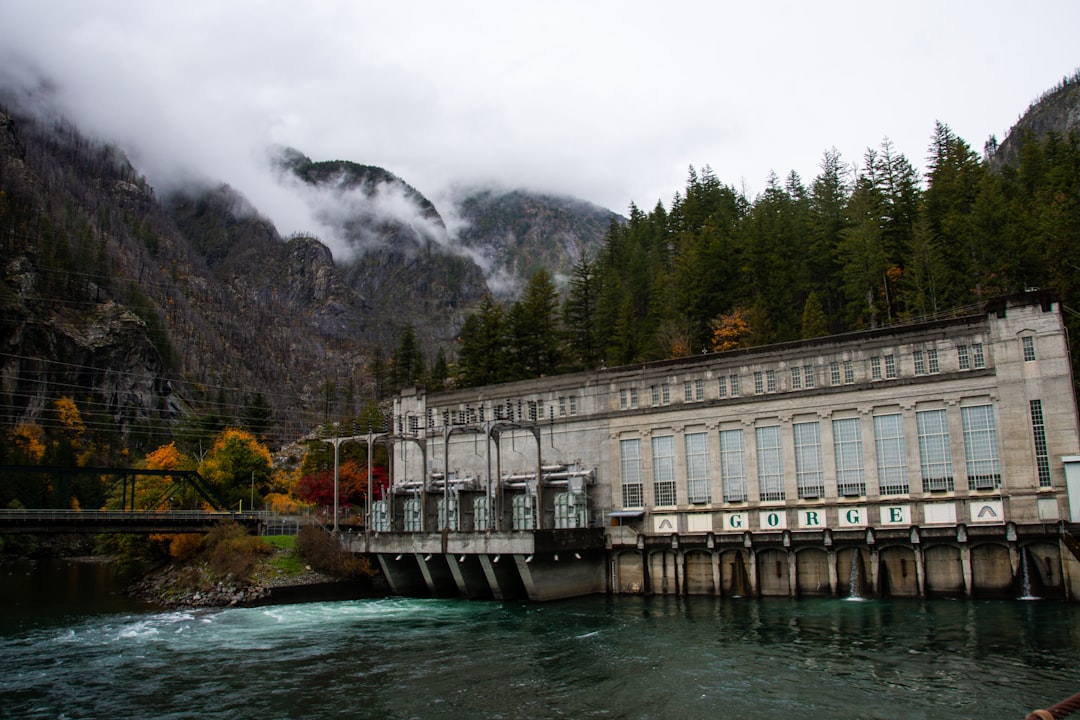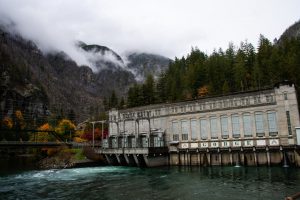Washington’s Hydropower Fuels Data Center Growth Concerns
Discover how Washington’s hydropower boom fuels data center growth and raises future sustainability concerns. Explore the impacts today.
Hydropower’s Impact on Washington‘s Data Centers
Abundance of Renewable Energy
Washington State is renowned for its vast hydropower resources, which provide an abundant and renewable energy source. The Columbia River and its tributaries host numerous dams that generate a significant portion of the state’s electricity.
This abundance of clean energy has been a major draw for data centers, which require substantial power to operate efficiently. Companies are attracted by the promise of lower energy costs and a reduced carbon footprint, making Washington an ideal location for their operations.
Economic Growth and Job Creation
The influx of data centers has spurred economic growth in Washington.
These facilities have created numerous job opportunities, ranging from construction and maintenance to IT and management roles. The presence of data centers has also stimulated local economies by increasing demand for services such as housing, retail, and transportation.
As a result, communities near these centers have experienced a boost in economic activity, contributing to the overall prosperity of the region.
Concerns Over Environmental Impact
Despite the benefits, there are concerns about the environmental impact of increased data center activity. The construction and operation of these facilities can lead to habitat disruption and increased water usage.
Additionally, while hydropower is a renewable resource, the infrastructure required to support data centers can strain local ecosystems and water resources. These environmental considerations have prompted discussions about sustainable practices and the need for careful planning to mitigate negative impacts.
Future Sustainability Challenges
As the demand for data centers continues to grow, questions about the sustainability of relying heavily on hydropower have arisen.
Climate change poses a threat to water levels and flow consistency, potentially affecting hydropower generation. This uncertainty has led to calls for diversifying energy sources and implementing energy-efficient technologies to ensure the long-term viability of data centers in the region.
Stakeholders are exploring innovative solutions to balance growth with environmental stewardship, ensuring that Washington remains a leader in sustainable data center operations.
Concerns Surrounding Hydropower’s Future in Washington
Environmental Impact
Washington’s reliance on hydropower has raised environmental concerns, particularly regarding its impact on local ecosystems. The construction and operation of dams can disrupt natural water flow, affecting fish migration patterns and aquatic habitats.
This disruption poses a threat to species such as salmon, which are crucial to the region’s biodiversity and indigenous cultures.
Moreover, the reservoirs created by dams can lead to the submersion of vast areas of land, potentially affecting terrestrial wildlife and vegetation. The alteration of river ecosystems can also lead to changes in water quality and temperature, further impacting aquatic life.
Climate Change and Water Availability
Climate change presents a significant challenge to the future of hydropower in Washington.
As global temperatures rise, changes in precipitation patterns and snowmelt timing could affect water availability for hydropower generation. Reduced snowpack and altered river flows might lead to decreased energy output during critical periods of demand.
These changes could necessitate the development of alternative energy sources or the implementation of adaptive management strategies to ensure a stable energy supply.
The uncertainty surrounding future water availability underscores the need for comprehensive planning and investment in resilient energy infrastructure.
Economic Considerations
While hydropower has been a cornerstone of Washington’s energy economy, there are concerns about its long-term economic viability. The initial costs of dam construction and maintenance are substantial, and the economic benefits must be weighed against potential environmental and social costs.
Additionally, the data center boom driven by affordable hydropower has led to increased energy demand, putting pressure on existing infrastructure.
Balancing the economic benefits of data centers with the sustainability of hydropower resources is a complex challenge that requires careful consideration and strategic planning.
Regulatory and Policy Challenges
The future of hydropower in Washington is also shaped by regulatory and policy frameworks. Stricter environmental regulations could impose additional costs on hydropower operations, potentially affecting their competitiveness with other renewable energy sources.
Policymakers must navigate the delicate balance between promoting sustainable energy development and protecting natural resources.
Furthermore, there is a growing call for increased investment in renewable energy diversification to reduce reliance on hydropower. This shift would require policy support and incentives to encourage the development of solar, wind, and other renewable energy technologies.
Sustainability Challenges for Washington’s Data Centers
Dependence on Hydropower
Washington’s data centers have largely thrived due to the state’s abundant hydropower resources, which provide a renewable and cost-effective energy source.
However, this dependence raises concerns about the future stability of energy supply. Climate change poses a significant threat to water levels in rivers and reservoirs, potentially affecting the availability of hydropower.
As the demand for data processing and storage grows, the strain on existing hydropower resources could lead to increased competition for energy, impacting both pricing and availability.
Data centers must explore diversified energy sources to mitigate these risks and ensure sustainable operations.
Environmental Impact
While hydropower is a cleaner energy source compared to fossil fuels, the environmental impact of data centers extends beyond energy consumption. The construction and operation of these facilities can lead to habitat disruption and increased water usage.
The cooling systems in data centers often require substantial water resources, which can be problematic in regions experiencing water scarcity.
To address these concerns, data centers in Washington need to implement more sustainable practices, such as advanced cooling technologies that minimize water usage and strategies that reduce their overall carbon footprint.
Regulatory and Community Pressures
As public awareness of environmental issues grows, data centers face increasing scrutiny from both regulatory bodies and local communities. There is a push for stricter regulations on energy consumption and environmental impact, which could lead to increased operational costs and the need for compliance with new standards.
Community opposition can also arise when data centers are perceived to be monopolizing local resources or contributing to environmental degradation.
Engaging with local stakeholders and demonstrating a commitment to sustainable practices are crucial for data centers to maintain their social license to operate.
Technological and Infrastructure Challenges
The rapid pace of technological advancement presents both opportunities and challenges for data centers in Washington. While new technologies can improve energy efficiency and reduce environmental impact, they also require significant investment in infrastructure upgrades and skilled personnel.
Data centers must balance the need to adopt cutting-edge technologies with the financial and logistical challenges of implementing these changes.
Investing in research and development, as well as collaborating with technology providers, can help overcome these hurdles and pave the way for more sustainable operations.
Balancing Growth with Environmental Conservation
The Rise of Data Centers in Washington
Washington State has experienced a significant increase in the number of data centers, largely driven by the availability of affordable and sustainable hydropower. This growth has been fueled by tech companies seeking to leverage the state’s renewable energy resources to power their operations efficiently.
The abundance of hydropower provides a cost-effective solution that aligns with the increasing demand for energy-intensive data processing facilities.
As a result, the region has become a hub for data center development, attracting major industry players and boosting local economies through job creation and infrastructure investment. However, this rapid expansion raises questions about the long-term sustainability of relying heavily on hydropower.
Environmental Concerns and Hydropower Limitations
While hydropower is a renewable energy source, it is not without environmental impacts.
The construction and operation of dams can disrupt local ecosystems, affect fish populations, and alter natural water flow, leading to concerns about biodiversity and habitat preservation. In Washington, these issues are particularly relevant given the state’s rich natural environment and the importance of its waterways.
Moreover, climate change poses a threat to the reliability of hydropower, as changing precipitation patterns and reduced snowpack can affect water availability.
This uncertainty raises concerns about the long-term viability of hydropower as the primary energy source for the growing number of data centers in the region.
Strategies for Sustainable Growth
To address these challenges, stakeholders are exploring strategies to balance growth with environmental conservation. One approach is to diversify the energy mix by incorporating other renewable sources, such as wind and solar, to reduce dependency on hydropower alone.
This diversification can enhance energy security and mitigate the risks associated with climate variability.
Additionally, implementing energy efficiency measures and adopting innovative cooling technologies can reduce the overall energy consumption of data centers. Encouraging collaboration between tech companies, environmental groups, and government agencies is also crucial to developing policies that promote sustainable development while protecting natural resources.
The Role of Policy and Regulation
Effective policy and regulation play a critical role in ensuring that the growth of data centers in Washington is aligned with environmental conservation goals.
Policymakers must establish clear guidelines and incentives that encourage sustainable practices and hold companies accountable for their environmental impact.
By setting ambitious targets for renewable energy use and emissions reductions, Washington can lead the way in demonstrating how economic growth and environmental stewardship can coexist. This balanced approach will be essential in securing a sustainable future for both the tech industry and the state’s natural ecosystems.
FAQ
Q1: How has Washington’s hydropower contributed to the data center boom?
A1: Washington’s abundant and affordable hydropower has attracted data centers due to its low electricity costs and renewable energy credentials. This has made it an ideal location for companies looking to reduce operational costs and their carbon footprint.
Q2: What are some common misconceptions about the sustainability of Washington’s hydropower?
A2: A common misconception is that hydropower is entirely free from environmental impact. While it is a renewable energy source, it can affect local ecosystems and water resources. It’s important to balance energy needs with environmental considerations.
Q3: What should investors consider before investing in data centers powered by Washington’s hydropower?
A3: Investors should evaluate the long-term sustainability of hydropower resources, potential regulatory changes, and the environmental impact of data center operations. Additionally, understanding the demand for data storage and processing is crucial for assessing expected returns.
Takeaway
“Maximize your trading potential now! Download our premium chart analysis guide for expert insights, sign up for early access to exclusive market insights, and follow real-time trade alerts to stay ahead of the game. Elevate your ROI with actionable strategies today.”











Comments